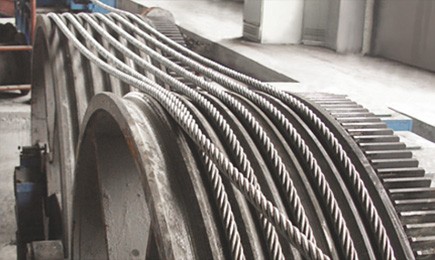Through the analysis of the broken wire structure of the outer strands of the ship unloader wire rope, it is believed that the short-term static friction between the wire rope and the pulley caused by the short-term static friction between the wire rope and the pulley leads to the appearance of martensite in the wire surface structure is the root cause of the reduction in the service life of the wire rope, and the improvement of the wire rope manufacturing process is adopted. The quality of the grease and increasing the amount of grease on the surface are important technical measures to increase the service life of the steel wire rope for this purpose.
The ship unloader wire rope can be divided into pitching wire rope, hoisting wire rope, grab wire rope and trolley traction wire rope according to the application part. Among them, the pitching wire rope has the longest service life, the trolley traction wire rope is the smallest, the hoisting wire rope and the grab wire rope are the largest and they are replaced most frequently. Under normal circumstances, the structure and specifications of the lifting wire rope and the grab wire rope are kept the same.
At present, the steel wire ropes used in ship unloaders have 6 strands and 8-strands in terms of the number of strands. According to the structural characteristics of the strands, they are divided into parallel twisted strands and compacted strands, and some use plastic filling technology. In the early days, ship unloader wire ropes were mainly imported brands, mainly Korean DSR, British BRIDON, German CASAR, and Japanese TESAC. Domestic products currently occupy a major share.
The short-term static friction between the wire rope and the supporting pulley is one of the important reasons for the early fracture of the wire. Through the comparison of the surface wear of the wire rope, combined with the actual improvement of the service life of the wire rope, the correctness of the technical measures to prevent the formation of martensite structure during use by strengthening the lubrication of the wire rope manufacturing process and reducing its friction with the matching pulley is verified. .
In the production of ship unloader wire ropes, non-asphalt-based surface greases with outstanding lubricating properties are used to reduce the friction between the wire ropes and the matching wheel grooves and have achieved good results. However, when increasing the rope drenching, it is still considered to avoid as much as possible Because the lubricating grease attached to the surface of the steel wire rope may still drip because of the excessive amount, it is not sufficient to spray the oil on the steel wire rope. From the actual tracking situation, the wear of the wire rope passing through the pulley section is still relatively heavy. In practice, due to the deflection angle, when the wire rope enters the pulley or drum, its motion state is no longer a simple linear motion, but a compound motion composed of linear motion and rotary motion. This form of movement determines that the steel wire rope has the characteristics of eccentric wear. The lubrication between the steel wire rope and the matching wheel groove surface is insufficient, and its appearance wear is undoubtedly more obvious. This is that the steel wire rope continues to wear during use after the strand and rope lubrication process. The main cause of unevenness.
The short-term static friction between the wire rope and the supporting pulley is one of the important reasons for the early fracture of the wire. Through the comparison of the surface wear of the wire rope, combined with the actual improvement of the service life of the wire rope, the correctness of the technical measures to prevent the formation of martensite structure during use by strengthening the lubrication of the wire rope manufacturing process and reducing its friction with the matching pulley is verified. .
In the production of ship unloader wire ropes, non-asphalt-based surface greases with outstanding lubricating properties are used to reduce the friction between the wire ropes and the matching wheel grooves and have achieved good results. However, when increasing the rope drenching, it is still considered to avoid as much as possible Because the lubricating grease attached to the surface of the steel wire rope may still drip because of the excessive amount, it is not sufficient to spray the oil on the steel wire rope. From the actual tracking situation, the wear of the wire rope passing through the pulley section is still relatively heavy. In practice, due to the existence of the deflection angle, the motion state of the wire rope when it enters the pulley or drum is no longer a simple linear motion, but a compound motion composed of linear motion and rotary motion. This form of movement determines that the steel wire rope has the characteristics of eccentric wear. The lubrication between the steel wire rope and the matching wheel groove surface is insufficient, and its appearance wear is undoubtedly more obvious. This is that the steel wire rope continues to wear during use after the strand and rope lubrication process. The main cause of unevenness.


 Jiangsu Taili Steel Rope Co., Ltd. covers an area of 5,000 square meters. It mainly produces high-quality steel wires and wire ropes of various specifications, with an annual production capacity of 30,000 tons and annual sales of 200 million yuan...
Jiangsu Taili Steel Rope Co., Ltd. covers an area of 5,000 square meters. It mainly produces high-quality steel wires and wire ropes of various specifications, with an annual production capacity of 30,000 tons and annual sales of 200 million yuan... Jiangsu Taili Steel Rope Co., Ltd. specializes in the production of high-quality steel wire ropes and steel wire rope products, and is committed to providing customers with a variety of high-quality steel wire and steel wire rope products...
Jiangsu Taili Steel Rope Co., Ltd. specializes in the production of high-quality steel wire ropes and steel wire rope products, and is committed to providing customers with a variety of high-quality steel wire and steel wire rope products... Pay attention to the real-time news or news released by Jiangsu Taili Steel Rope, and provide you with first-hand information about us!
Pay attention to the real-time news or news released by Jiangsu Taili Steel Rope, and provide you with first-hand information about us! The company's products have passed the ISO9001 quality system certification, and passed the ISO14001 environmental management system certification in 2008, to obtain better profits for customers in satisfactory use
The company's products have passed the ISO9001 quality system certification, and passed the ISO14001 environmental management system certification in 2008, to obtain better profits for customers in satisfactory use Taili always puts high-quality service in the same important position as the product, and uses a professional and high-standard service system to let customers feel the greatest heart and sincerity of Taili Steel Rope throughout the process, so as to achi
Taili always puts high-quality service in the same important position as the product, and uses a professional and high-standard service system to let customers feel the greatest heart and sincerity of Taili Steel Rope throughout the process, so as to achi Thank you for your attention to Taili. If you have any cooperation needs about products or services, please contact us in time; After receiving your consultation information, Taili’s service consultants will understand your needs in detail within 24 hours
Thank you for your attention to Taili. If you have any cooperation needs about products or services, please contact us in time; After receiving your consultation information, Taili’s service consultants will understand your needs in detail within 24 hours